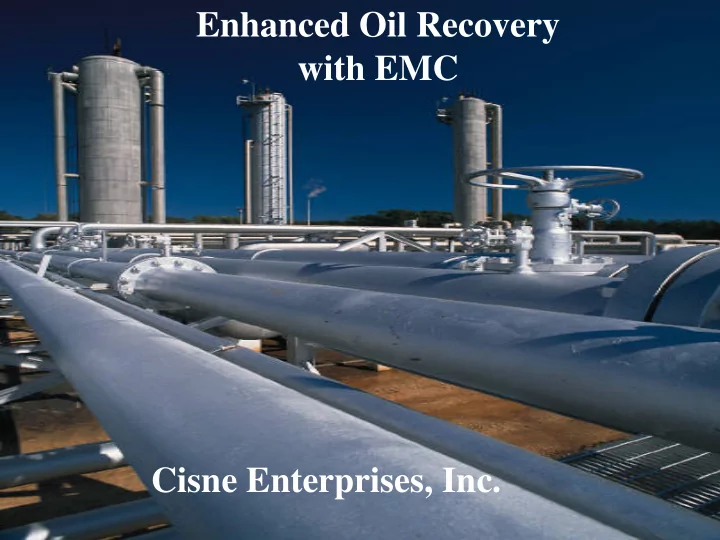

Enhanced Oil Recovery with EMC Cisne Enterprises, Inc.
The Industry Two thirds of the United States oil reserves are still intact. Today’s methods of oil and gas extraction are limited. With the political climate around the world, we must develop and use the most innovating technologies to minimize our dependence from foreign oil. Cisne has a technology that is more efficient and cost effective.
EOR Enhanced Oil Recovery In most oil fields, only a fraction of the oil can be produced by natural reservoir pressure and by conventional methods such as pumping. Often, as much as 75 percent of the oil can remain in a reservoir after primary recovery. The remaining, or residual, oil can be recovered only by using recovery methods that restore pressure and fluid flow in underground formations through the introduction of water, gas, chemicals, heat, or a combination of these, into the reservoir. These recovery methods are often referred to as enhanced or improved recovery methods. A further distinction is made between secondary recovery methods, which often refers to pressure maintenance methods, and tertiary recovery methods, which often refers to methods that improve oil displacement. The major methods of enhanced oil recovery (EOR) are: water flooding gas injection chemical flooding thermal recovery Gas injection may be immiscible or miscible (unable or able to mix with oil). Water flooding (the most widely used recovery method) and immiscible gas injection are pressure maintenance methods and are generally used in secondary recovery. Thermal recovery lowers the viscosity of the oil and increases its flow by introducing heat into the reservoir.
Cavachem Process Cisne’s EOR method, CavaChem, consists of an injection tool and a patented chemical, EMC CavaChem uses cavitational waves and EMC to achieve optimal penetration throughout the production zone. CavaChem creates cavitation by accelerating a EMC fluid stream through a restricted area, creating a reduction in pressure. The molecules of the liquid in the low pressure zone are literally pulled apart by force and changed into gas bubbles. Downstream the fluid undergoes a deceleration process resulting in a reveral o fthe energy and raising the pressure above the vapor stage. The bubbles can not exist at the increased pressure and are forced to collapse or implode. These implosions are the most effective part of the cavitation process and causes increased penetration of the EMC. This action reduces the interfacial tension of the well, improves permeability and Enhances Oil Recovery. The Cavachem Process is: Effective - Practical - Economical - Environmentally Safe Because each well is different, it is essential to analyze the well characteristics, including formation, depth, prior chemical use , etc., to determine the proper treatment protocol.
Cavachem Tool Enhanced Oil Recovery (EOR) Injection Tool Fluid Flow Screen Filter Section #1 Fluid Flow Cement Section #2 Energy Chamber Casing Production Fluid Flow Tubing Section #3 Collection Chamber Fluid Flow Perforations Section #4 Spraying Chamber
Recommend
More recommend